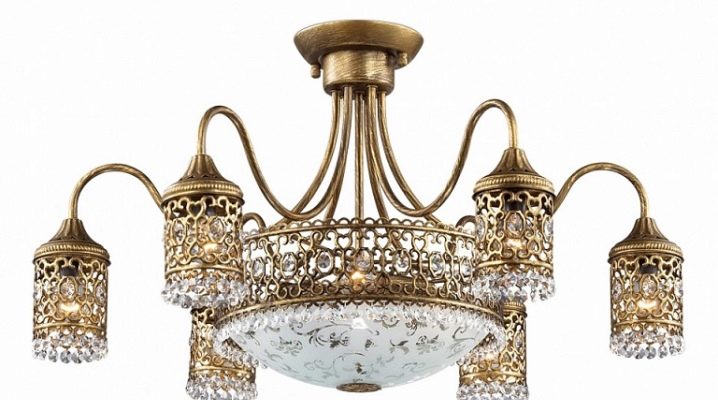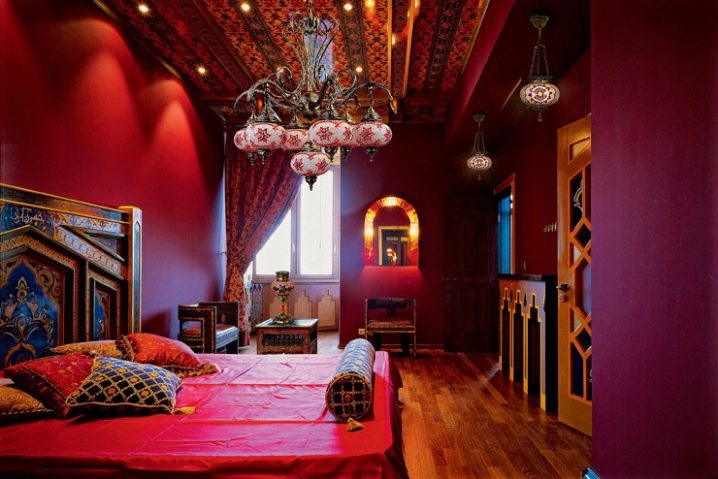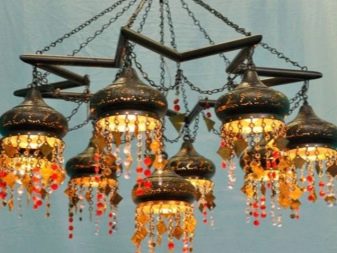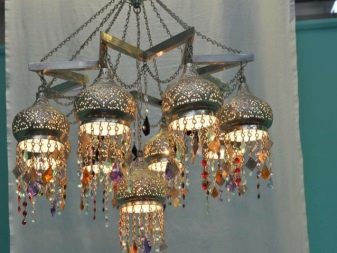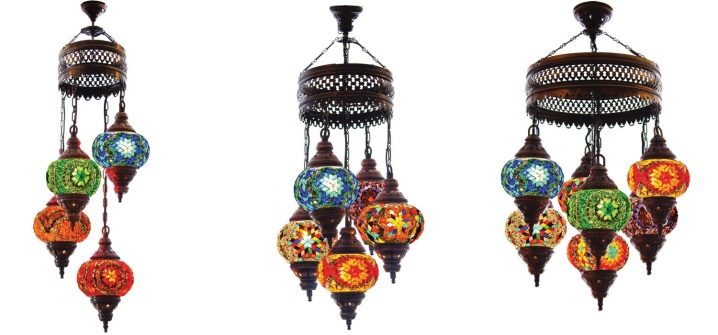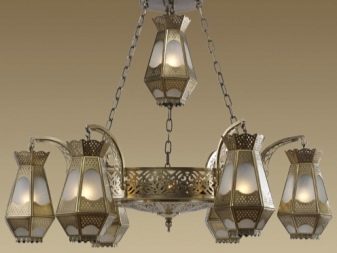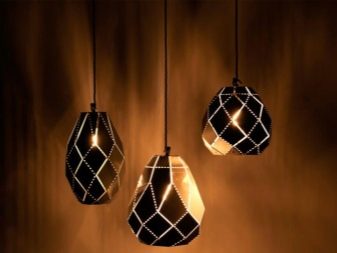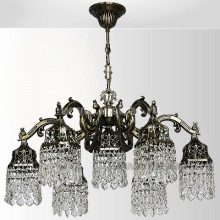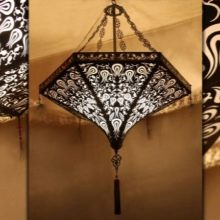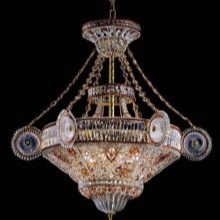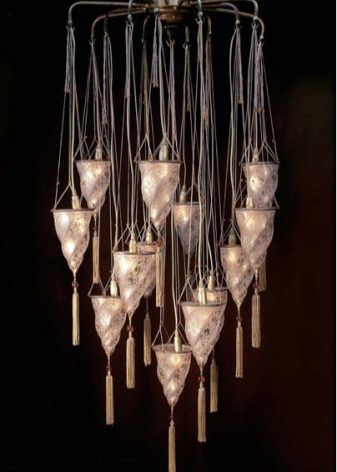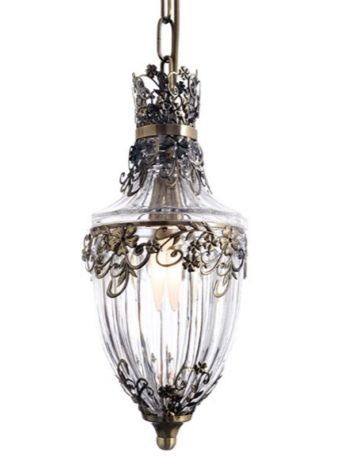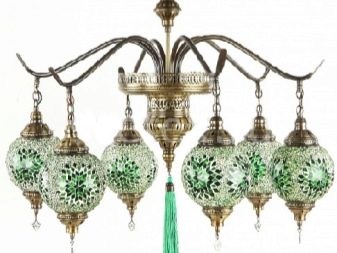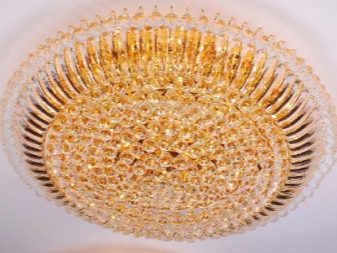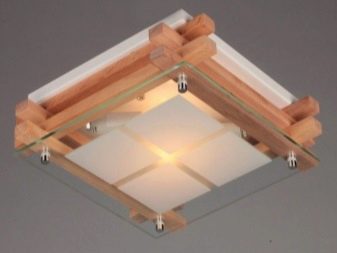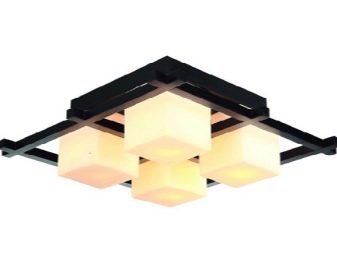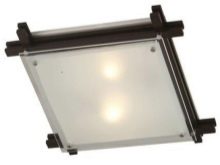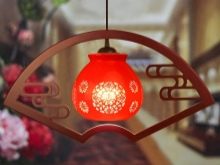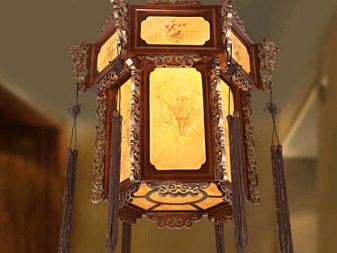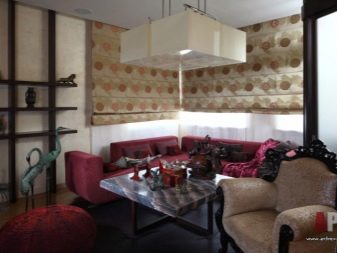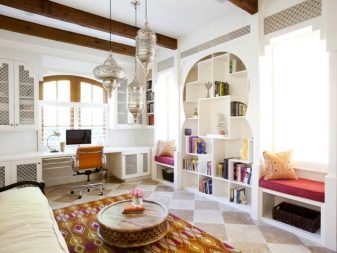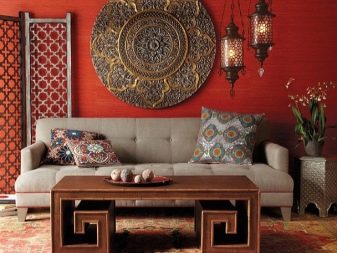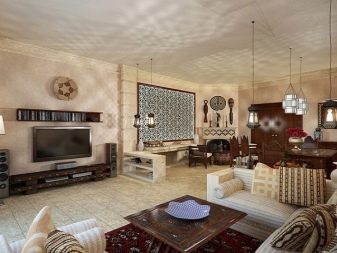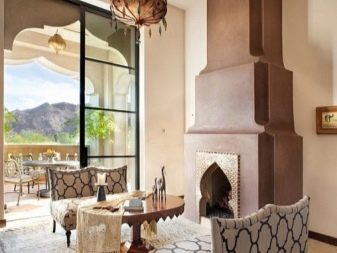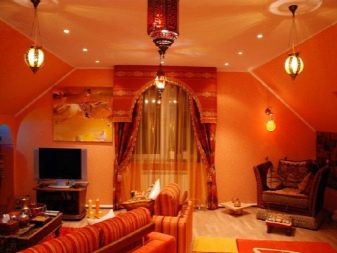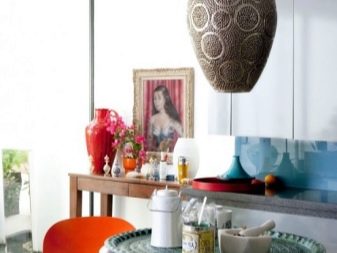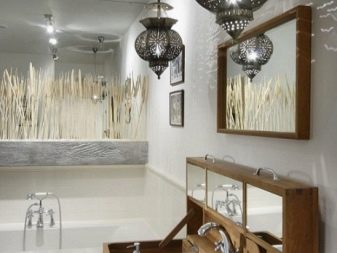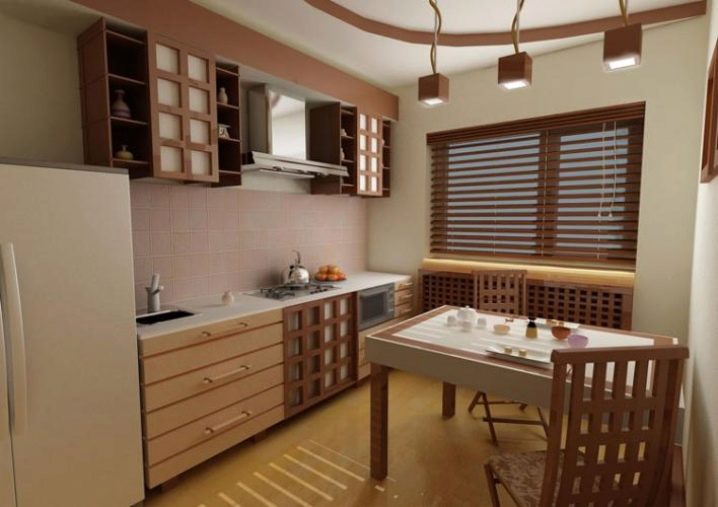Chandeliers in oriental style
Oriental style is a very capacious concept that unites the cultures of such unlike countries. Hence the richness of the decorative methods: saturation of the color palette, stained glass elements, mosaic, silk, carving, gilding. With all the diversity there is something in common, namely, the uniqueness of each element. In the eastern decor, lighting devices play a significant role, which have significant differences from other light sources.
First of all, the oriental chandelier is an important part of the interior, which creates a mysterious atmosphere with its subdued light.
Stylistics and materials
Chandeliers in oriental style have diffused light, which the ceiling lamp distributes evenly over the entire area of the room. At the same time they are united by the absolute uniqueness of each model.In addition to common features, the eastern direction can be divided into many different stylistic trends that carry the characteristics of each culture.
Consider the main styles of oriental chandeliers.
Arab
Chandeliers of this style have a luxurious and expensive decor: crystal pendants, colorful crystals, gilded fragments, complex intricate shapes. All this, as well as the characteristic shape of the dome, distinguishes the design of these ceiling light sources.
Turkish
Ottoman-style Turkish chandeliers are especially refined and elegant. The lamps are round in shape, made of hammered metal and glass.
Moroccan
Chandeliers of this style are generally hexahedral. These are openwork lanterns for which they use bronze, copper, brass, silver alloy. The shade is decorated with the finest, like a cobweb, metal threads with curls, as well as colorful glass and mosaic. Separate models of this style are made manually.
Arab-Turkish and Moroccan chandeliers demonstrate the most magnificent and luxurious branch of the oriental style, which is replete with decorative elements and rich materials, which mainly use natural ingredients:
- metal (gold, silver, copper, bronze, brass);
- crystal (transparent, with a shade);
- glass (matte, transparent, color, mosaic);
- Swarovski crystals.
Mauritanian
Mauritanian chandeliers are characterized by a cone shape, they can be elegantly twisted, always with long pendants. The difference between such products in delicate pastel colors, as well as in their size (not very large). These models are made of the famous Murano glass, decorated with patterns and ornaments.
The material for the Moorish chandelier can be:
- Metal (copper, brass, bronze);
- Ceramics;
- Murano glass.
Egyptian
Traditionally, Egyptian ceiling lights are a symbol of the sun. Therefore, the products are made in the shape of a circle. The decorations are a specific ornament based on symmetry, as well as crystal details. The color scheme is also symbolic - these are mainly sunny and sandy shades.
Egyptian ceiling chandeliers are made of materials such as:
- Metal (copper, bronze);
- Crystal;
- Glass.
Japanese
Bright representatives of Oriental minimalism are Japanese ceiling lamps, which are distinguished by conciseness and stinginess of form and color. The Japanese chandelier is, first of all, a construction based on a square or rectangle. Contrasting colors: combinations of black with white or beige with brown.In one product there is a maximum of 3-4 colors.
Particularly popular nowadays are fashionable chandeliers decorated with paper figures in the style of origami.
Such chandeliers have a light, almost weightless, visual design. Ceiling products are made only from natural materials, which are also distinguished by rigor and simplicity:
- wood;
- bamboo;
- paper (including rice);
- textiles (wool, silk);
- glass (only frosted).
Chinese
Categories of philosophy, such as simplicity, nature, energy, are directly reflected in the Chinese ceiling lamps. Chandeliers decorate images of hieroglyphs, nature, dragons. At the same time, the products are diverse in shape and material.
Chinese chandeliers are made from environmentally friendly natural materials:
- Natural silk;
- Porcelain;
- Paper (often rice);
- Bamboo;
- Glass (often frosted).
Use in the interior
The interior today is often used extremely straightforward forms. However, recent trends show that the most minimalist interior may contain a bright or particularly interesting detail. In this connection, Oriental-style lamps are popular, which, with their originality and originality, can dilute the monotony and add uniqueness.
Oriental chandelier will decorate almost any room, and for different functional areas will be appropriate to their kind of lamps.
In the living room or office will need lighting with greater brightness. Here are relevant wall sconces, as well as oriental ceiling chandeliers that give light to the room, but not distracting from work.
The range of oriental models is rich. Particularly worth mentioning universal lamps, they are used as a ceiling and as a wall option. This helps to solve the problem of insufficient light or limited space.
Modern interior design is different mix of different styles. Given the originality of the East, it is impossible to simply take an interior chandelier with Arabic or Japanese notes. Here support is needed in the design of the entire room.
If your home has bright decoration with the use of murals, embroidered bedspreads and carpets, in this case, the Arabian-style chandelier will fit perfectly into the decoration of the room and become its true decoration. If in the bedroom there is a canopy over the bed, organza curtains and embroidered pillows, then a strong accent is needed, such as a luxurious Arabian chandelier that has gilding, crystals, and crystal.
In the sunny living room, where there are carpets and bedspreads in beige tones, soft puffs, walls with monograms and gilding, an Egyptian chandelier will look appropriate. The colorful room, distinctively decorated with African ethnic details, will successfully complement the Moroccan ceiling chandelier.
The direction of Morocco stands out for its continuous play of light. The openwork metal designs are decorated with crystals and colored glass, these transparent inclusions paint unusual pictures with the help of light.
Moorish chandeliers are the most versatile compared to other luxurious oriental lamps. Moorish design can add luxury to a simple interior, but at the same time, too elaborate design of the room makes it softer. Ottoman chandeliers are ideal for a classic interior, made in bright colors.
Chandeliers in oriental style loved in our country for a long time. Now they decorate not only housing. Stylish oriental chandeliers are part of the decoration of almost any public space: for example, they are found in hotels and rest houses, restaurants and cafes.
Arab-Turkish style is relevant for the design of hotel or tourist complexes. Minimalism of Asia will make the interior of a hall of negotiations, business meetings, seminars refined and sophisticated.
Speaking of the East and lamps, one can not forget about the chandeliers for the hammam - the Turkish bath. Aromatherapy, physical and spiritual rest today accompany us after a hard working week, similar to a Russian bath or sauna.
Many homeowners arrange a hammam inside a country house: a room where you can relax and unwind.
Chandelier for the hammam, made in the traditional Oriental style, must be resistant to high humidity and temperature.
Such models of Turkish and Moroccan areas are exceptionally beautiful and elegant.
Oriental minimalism is also interesting and relevant. The tendency toward philosophy, a sense of space and reality in China’s civilization is similar to the Japanese direction. The Chinese chandelier is a cross between pomp and modesty of the eastern interior. Chinese style does not differ flashy brightness, it has smooth soft borders and some depth.
Japanese and Chinese notes are always consonant in the assessment of interior items. The style of Japan abounds in a light palette, which can be emphasized by a contrasting line: the contrast of dark and light tones. Thanks to its laconic design, Japanese ceiling chandeliers fit easily into any stylistic design. However, the room executed in the restrained style of the Land of the Rising Sun will be seen as spectacular: laconic lines and beauty with a slightly dimmed light from the chandelier.
There are two principles of Japanese minimalism, in relation to lighting in residential areas:
- Nothing superfluous and distracting from the contemplation of the main advantages of being.
- The comfort of the surrounding objects should be maximized.
The organization of the lighting system must be as convenient and functional as possible. From here the minimum color scale and strict forms of illuminants. In this case, a prerequisite is efficiency, all designs of ceiling chandeliers are designed to use energy-saving lamps.
Review the models of chandeliers in the Japanese style, see the following video.
